Articles
Charlie Anglemire: CF Martin production worker and hobby instrument builder
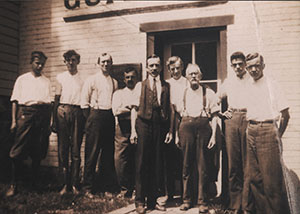 I recently had the opportunity to examine and appraise several instruments that were built by a man who built instruments at CF Martin & Co. in the early 20th century, but who also built in his spare time as a hobbyist. As I found these instruments and the story of the builder to be interesting I wanted to share the story for Guitarmaker.
I recently had the opportunity to examine and appraise several instruments that were built by a man who built instruments at CF Martin & Co. in the early 20th century, but who also built in his spare time as a hobbyist. As I found these instruments and the story of the builder to be interesting I wanted to share the story for Guitarmaker.
In August of 2012 I was contacted by a friend regarding three instruments that had come down through his family. The instruments were built by C. N. (Charlie) Anglemire (1876-1942), grandfather of Alice Yeakel of Nazareth PA, who had been custodian of these instruments since shortly after Charlie’s death. According to family history and Martin employment records, Charlie Anglemire was an employee of the Martin factory from 1906-1917. C. N. Anglemire can be seen in the photo printed above, which shows the Martin production floor staff circa 1915. No documentation exists to show exactly what Anglemire did on the Martin production line, though it is certain that he worked on the factory floor. While it can be safely assumed that he worked in guitar production, given that this era was the period in which Martin made the largest number of mandolins, it may also be safe to assume that Anglemire may have had experience building mandolins as well as guitars. A review of the photos of these instruments will clearly show at least an aesthetic relationship between some aspects of Martin’s bowl back mandolin designs and Anglemire’s own guitar and mandolin building.
While employment records don’t shed much light on Charlie’s activities while ‘on the clock” for Martin, company sales records do give some detail about his private pursuit of luthiery. A number of purchase entries bear his name. In fact, as early as 1902 there are records of Martin selling a 1-30 (SN. 8328) guitar and also strings to “C. N. Anglemire & Co.” of Pocono Lake, PA. According to the Yeakel family Anglemire lived in Weatherly, PA (just 30 miles from Pocono Lake) prior to moving to Nazareth in 1905. It is tempting to speculate that C. N. Anglemire & Co. was perhaps a music store owned by Charlie, but no documentation or family history clearly establishes this. Once employed by Martin (1906) Anglemire purchased guitars (including a 00-28 and 000-45), mandolins of various styles, and cases. But there are also entries showing parts purchased for his own pursuit of instrument craft. There is an entry reflecting “supplies for repairing Dr. Bird’s guitar”, as well as purchases of tuners, varnish and “parts for an 0-42 guitar”. There are entries recording “trimmings for special mandolin” and “German silver machines with inlaid buttons” that are likely the same as show up on the instruments shown below. There is also an entry for ‘refinishing 1-30 guitar”, perhaps the same one purchased by Anglemire in 1902.
According to Alice Yeakel, Charlie Anglemire was an avid musician and often had friends over to the house to play. But sometime in early 1917 Charlie lost several fingers from one hand in an accident. Martin records reflect that he worked his final four months in an office position rather than on the production floor, most likely as a result of his injury. Anglemire resigned from his position at Martin on August 4th, 1917. Mrs. Yeakel can recall that her grandfather was indeed missing several fingers but does not know if the accident that claimed the digits happened on the factory floor. No accident records relating to Anglemire could be found among Martin employee documents.
While Charlie was working at Martin he built the three instruments I was summoned to see, though these are not the only instruments he built that still exist. The family is in possession of two additional guitars built by Anglemire, one of which is a harp guitar. The instruments show clear Martin influence they also differ from Martins significantly, revealing Anglemire’s own ideas about acoustics, engineering and ornamentation. Each of these instruments bears some resemblance to Martin production models, but each is distinctly different from anything Martin made. Within several weeks of my trip to Nazareth to see these instruments they were acquired by Martin and are now on display in the museum on Sycamore St in Nazareth.
THE INSTRUMENTS
Each of these instruments reflect the highest level of craftsmanship in both the wood working aspects and finishing. The craft reflected on each is akin to what is seen on Martin guitars of this era. Fit and finish are superb. Though each instrument has had a few repairs over the years they remain exceptionally well preserved.
Instrument #1: Mandolin, Dated Sept. 25, 1914
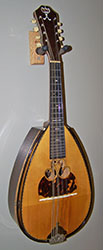 This mandolin is stamped on the brace closest to the soundhole with the date “Sept. 25, 1914.” This is the only instrument of the three which bears a
This mandolin is stamped on the brace closest to the soundhole with the date “Sept. 25, 1914.” This is the only instrument of the three which bears a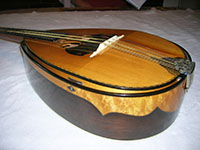 date. It has a Brazilian rosewood body, spruce top, ebony fretboard, elegantly carved ivory bridge and ivory ornamental accents along with pearl fretboard inlay. The instrument has a bent top and an elongated tear-drop body shape like a bowl back mandolin. The body of the mandolin is constructed so that the top and sides are attached with a series of small screws to a back and second set of sides with a slightly larger profile,
date. It has a Brazilian rosewood body, spruce top, ebony fretboard, elegantly carved ivory bridge and ivory ornamental accents along with pearl fretboard inlay. The instrument has a bent top and an elongated tear-drop body shape like a bowl back mandolin. The body of the mandolin is constructed so that the top and sides are attached with a series of small screws to a back and second set of sides with a slightly larger profile,  allowing the top and sides to slip into the larger back and side assembly, similar to the way the a banjo back mates to the rim. These screws are anchored in decorative, diamond shaped ivory lugs that are inlaid into the rosewood sides. While not exactly the same in execution, perhaps this design was partly inspired by Martin’s “Model America” guitar, which featured a double body construction unique to that model (only 2 were
allowing the top and sides to slip into the larger back and side assembly, similar to the way the a banjo back mates to the rim. These screws are anchored in decorative, diamond shaped ivory lugs that are inlaid into the rosewood sides. While not exactly the same in execution, perhaps this design was partly inspired by Martin’s “Model America” guitar, which featured a double body construction unique to that model (only 2 were 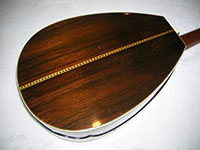 made). The purflings are very Martin-esque, in fact, the “diamond” back strip and end graft are identical to those found on some early to mid-19th century
made). The purflings are very Martin-esque, in fact, the “diamond” back strip and end graft are identical to those found on some early to mid-19th century 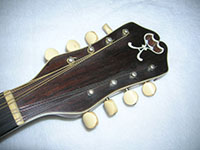 Martin guitars,but Martin’s useof this purfling on production instruments stopped by the 20th century. The headstock shows the same scroll shape that Martin used on their bowl back mandolins, but this one shows a stylized “A” for the maker’s last name.
Martin guitars,but Martin’s useof this purfling on production instruments stopped by the 20th century. The headstock shows the same scroll shape that Martin used on their bowl back mandolins, but this one shows a stylized “A” for the maker’s last name.
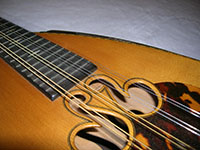 Perhaps the most interesting design feature of this mandolin is that there is a second spruce top inside the body, attached to the inner set of sides, suspended about 1” inside the visible top. This second top can be seen in the photos showing the lyre-shaped sound hole. Also of
Perhaps the most interesting design feature of this mandolin is that there is a second spruce top inside the body, attached to the inner set of sides, suspended about 1” inside the visible top. This second top can be seen in the photos showing the lyre-shaped sound hole. Also of 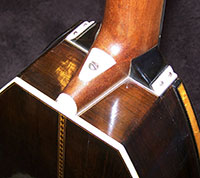 interest is the neck joint, which features a 19th century style “clock key” angle adjustment. Finally, the body shows a beautiful bird’s eye maple ornamental band around the rim, which is very similar to what was found on bowl back mandolins of the 19th and early 20th century (see photo #2). It may be fair to speculate that Anglemire was involved in the building of bowl back mandolins at Martin given the carry-over of this feature to his own non-bowl back instruments.
interest is the neck joint, which features a 19th century style “clock key” angle adjustment. Finally, the body shows a beautiful bird’s eye maple ornamental band around the rim, which is very similar to what was found on bowl back mandolins of the 19th and early 20th century (see photo #2). It may be fair to speculate that Anglemire was involved in the building of bowl back mandolins at Martin given the carry-over of this feature to his own non-bowl back instruments.
Instrument #2: undated 0 size 12 fret guitar
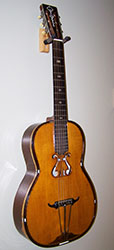 The second instrument is a guitar that on the surface conforms superficially to Martin specs for an 0 size guitar, but the body size, shape
The second instrument is a guitar that on the surface conforms superficially to Martin specs for an 0 size guitar, but the body size, shape  and scale length is where the similarity ends. Like the mandolin, this guitar has the double top, and the same side design incorporating two sets of sides that fit into one another). It also shows 19th century style purflings, style 45 fretboard inlays, engraved Waverly tuners with inlaid Handel buttons, a maple body accent around the rim (similar to the mandolin), and a clock key neck adjustment. The bridge profile harkens back to European design “moustache” bridges of the 19th century), some of which were found on very early Martin made Stauffer style guitars of the 1830s. Though the guitar has a pin bridge it also sports an original trapeze style tailpiece that extends over top of the bridge and has holes
and scale length is where the similarity ends. Like the mandolin, this guitar has the double top, and the same side design incorporating two sets of sides that fit into one another). It also shows 19th century style purflings, style 45 fretboard inlays, engraved Waverly tuners with inlaid Handel buttons, a maple body accent around the rim (similar to the mandolin), and a clock key neck adjustment. The bridge profile harkens back to European design “moustache” bridges of the 19th century), some of which were found on very early Martin made Stauffer style guitars of the 1830s. Though the guitar has a pin bridge it also sports an original trapeze style tailpiece that extends over top of the bridge and has holes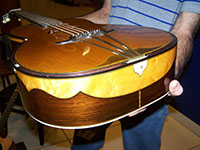
 to accommodate the bridge pins, which go through the tail piece and into the bridge. Rounding out the list of interesting features of this guitar is a conical sound hole insert, just below the lyre sound hole. The insert is mounted on a sound post that runs from the top to the back of the guitar, and is a small resonator like cone similar to (though considerably different than) a classical guitar tornavoz.
to accommodate the bridge pins, which go through the tail piece and into the bridge. Rounding out the list of interesting features of this guitar is a conical sound hole insert, just below the lyre sound hole. The insert is mounted on a sound post that runs from the top to the back of the guitar, and is a small resonator like cone similar to (though considerably different than) a classical guitar tornavoz.
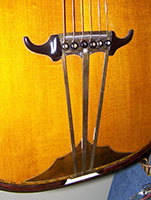 This guitar is undated. However, the Martin sales records record a sale to Anglemire on 6/26/1916 of
This guitar is undated. However, the Martin sales records record a sale to Anglemire on 6/26/1916 of 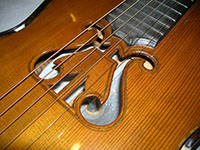 “German silver guitar machines with inlaid buttons”. The tuners on this guitar, engraved plate German silver Waverly tuners with Handel inlaid buttons may well be the tuners referenced in that entry, as there are no other sales entries of similar style guitar tuners noted as sold to Anglemire. If so that would date the guitar to mid-1916.
“German silver guitar machines with inlaid buttons”. The tuners on this guitar, engraved plate German silver Waverly tuners with Handel inlaid buttons may well be the tuners referenced in that entry, as there are no other sales entries of similar style guitar tuners noted as sold to Anglemire. If so that would date the guitar to mid-1916.
Instrument #3: undated taropatch
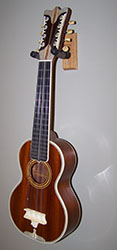 The third instrument is a taropatch ukulele in mahogany. This instrument bears as close a resemblance in form to its Martin cousins as do theguitar and mandolin, and Anglemire’s own ideas find expression mainly in the
The third instrument is a taropatch ukulele in mahogany. This instrument bears as close a resemblance in form to its Martin cousins as do theguitar and mandolin, and Anglemire’s own ideas find expression mainly in the  form ofornamentation. Most interesting is the unusual ivory bridge, the bird’s eye maple veneer on the back of the headstock, and the ivory and purfling inlay scheme of the front face of the headstock (photo 16). There is no date or signature evident on the taropatch.
form ofornamentation. Most interesting is the unusual ivory bridge, the bird’s eye maple veneer on the back of the headstock, and the ivory and purfling inlay scheme of the front face of the headstock (photo 16). There is no date or signature evident on the taropatch.
As a full time luthier who started as a hobby builder, I find the story of Charlie Anglemire and his instruments of great interest. Here was a guy who had a hand in building some of the 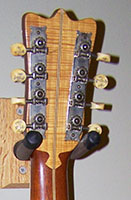 finest instruments ever made, instruments of elegant design and thehighest level of craftsmanship, who at the end of the day went home and put his own ideas to work on those classicdesigns. The instruments he left behind show the influence of
finest instruments ever made, instruments of elegant design and thehighest level of craftsmanship, who at the end of the day went home and put his own ideas to work on those classicdesigns. The instruments he left behind show the influence of 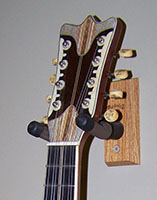 having worked at Martin, but also the imagination and creativity of a craftsman who had his own ideas and worked on his own time to put those ideas to practical application. This is much the way many of us work today, with a firm foundation in traditional design and craftsmanship but a desire to try new things in our design and craft. These instruments stand as an example of one man’s imagination, an example that can serve as inspiration to the luthiers of today.
having worked at Martin, but also the imagination and creativity of a craftsman who had his own ideas and worked on his own time to put those ideas to practical application. This is much the way many of us work today, with a firm foundation in traditional design and craftsmanship but a desire to try new things in our design and craft. These instruments stand as an example of one man’s imagination, an example that can serve as inspiration to the luthiers of today.
I would like to acknowledge and thank Dick Boak for his consultation and assistance as well as making the Anglemire instruments available for photography for this article. Likewise, thanks to Greig Hutton for his research in the Martin archives regarding Anglemire’s term of employment at Martin. Early 20th century Martin production staff photo courtesy of C.F. Martin Archives and used by permission.